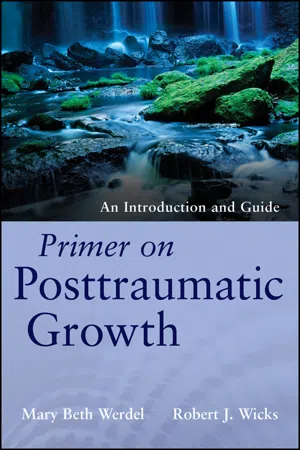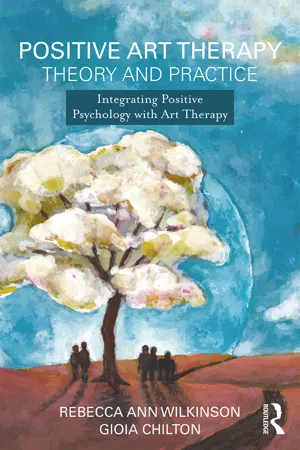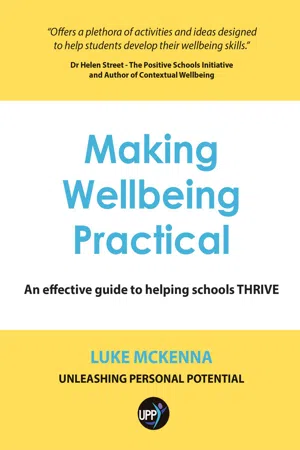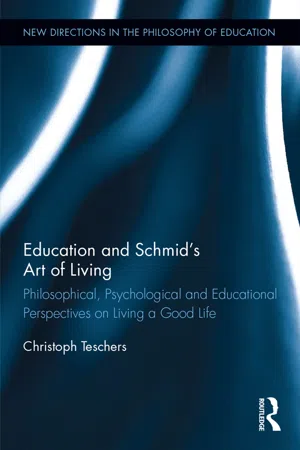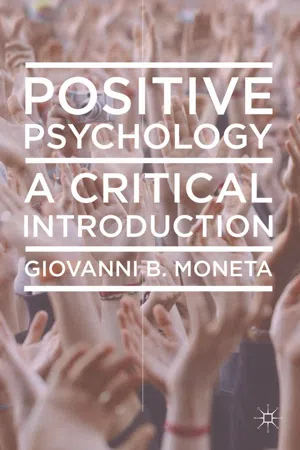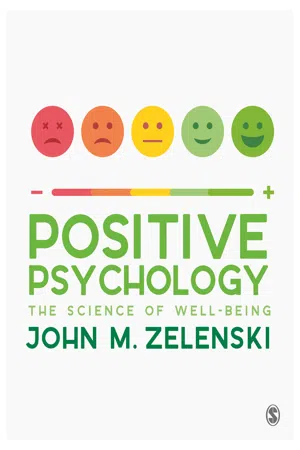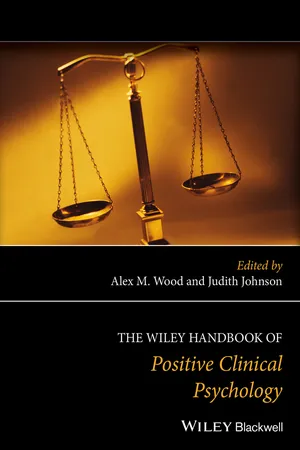Psychology
Positive Emotions
Positive emotions refer to feelings such as joy, gratitude, and contentment that contribute to overall well-being and happiness. These emotions are associated with improved mental and physical health, resilience, and better coping strategies. Positive emotions play a significant role in enhancing social connections, creativity, and overall life satisfaction.
Written by Perlego with AI-assistance
Related key terms
11 Key excerpts on "Positive Emotions"
- eBook - ePub
Primer on Posttraumatic Growth
An Introduction and Guide
- Mary Beth Werdel, Robert J. Wicks(Authors)
- 2012(Publication Date)
- Wiley(Publisher)
Positive affectivity is defined by Peterson (2006) as the dispositional tendency to habitually experience Positive Emotions such as joy, interest, and alertness. Measures of positive affect attempt to capture the frequency with which a person feels such positive emotional states as cheerfulness, calmness and peacefulness, extreme happiness, and being satisfied and full of life (Brim & Featherman, 1998). Positive affect is also connected to the definition of subjective well-being—what one may consider the traditional definition of well-being that captures a specific aspect of a person's overall belief that life is good (Peterson, 2006). Specifically, subjective well-being is constructed as the combination of high levels of positive affect along with low negative affect and high life satisfaction (Diener, 1984).We know that positive affect is associated with many positive aspects of life, such as increased social activity, friends, involvement in organizations, being happily married, finding enjoyment in vocation, religiosity and spirituality, life satisfaction (Peterson, 2006), and happiness (Fredrickson & Joiner, 2002). Positive affect has also been found to be associated with several positive physical health indicator,s such as improved immune system functioning (Davidson et al., 2003), improved cardiovascular activity (Fredrickson, Mancuso, Branigan, & Tugade, 2000), and longevity (Danner, Snowdon, & Friesen, 2001). We see from the aforementioned correlations that Positive Emotions are related to healthy, meaningful, growth-oriented experiences in life. A deeper look into Positive Emotions makes it abundantly clear that Positive Emotions possess a good deal of power in an individual's emotional life.The Power of Positive EmotionsFor some time, psychology was solitary symptom-focused and as such exclusively examined negative emotions. However, in the 1990s, in the wake of the positive psychology movement, Barbara Fredrickson and colleagues began giving specific and focused attention to the power of Positive Emotions. Until the positive psychology movement, Positive Emotions did not receive any truly focused attention. Rather, negative emotions captured the attention in ways that Positive Emotions did not. However, many people's research efforts, including Fredrickson's, have permanently changed the field. Fredrickson documented in her groundbreaking experiments evidence to support her innovative theory of Positive Emotions, known as the Broaden and Build Theory of Positive Emotions - eBook - ePub
Positive Art Therapy Theory and Practice
Integrating Positive Psychology with Art Therapy
- Rebecca Ann Wilkinson, Gioia Chilton(Authors)
- 2017(Publication Date)
- Routledge(Publisher)
This contributes to the capacity to cope with and bounce back from negative experience. Building and strengthening coping resources and the ability to manage stressors promotes greater resilience, which leads naturally to more positive experiences and emotions. This cycle generates the upward spiral of Positive Emotions, a reversal of the downward spiral that commonly manifests in depression, hopelessness, and pessimistic thinking (Garland et al., 2010). p.67 The beneficial impact of Positive Emotions on resilience appears most pronounced when we are able to find positive meaning in the difficulties we encounter. This process of positive reappraisal does not mean that we minimize our losses but that we are able to extract something positive from what we have experienced (Sears, Stanton, & Danoff-Burg, 2003). The relationship between finding positive meaning in challenges, also called benefit-finding (Helgeson, Reynolds, & Tomich, 2006), and Positive Emotions appears to be reciprocal as well—finding positive meaning induces more Positive Emotions, which in turn broadens thinking and inspires more positive perception of events. We will explore this critical dynamic more fully in Chapter 11 on meaning making and perception. What Are Emotions? Before we continue discussing Positive Emotions, we might step back and take a moment to consider what emotions are in general. The etymology of the word “emotion” traces back to old French and Latin terms meaning “to move” and even “to dance”! This makes sense because most of us experience our emotions in the body—from the heart-pounding sensation of fear, to the bounce in our step from joy, the tear-jerking pull of grief and sadness, and the serene exhale of contentment and peace. This also makes sense because our emotions often move us into action, spurring us on to do things. Emotions also move on by, like the weather, quickly changing - eBook - ePub
- Meg A. Warren, Stewart I. Donaldson, Meg A. Warren, Stewart I. Donaldson, Meg A. Warren, Stewart I. Donaldson(Authors)
- 2017(Publication Date)
- Praeger(Publisher)
Another conceptualization of emotion proposes that the true elements of emotion in human nature are not discrete categories such as fear and anger, but instead continuous dimensions, such as positive versus negative valence of feeling, degree of activation or arousal, and motivational direction of approach versus avoidance (e.g., Barrett, 2006; Cacioppo, Berntson, Norris, & Gollan, 2011; Harmon-Jones, 2003; Russell, 2003). Although different theorists emphasize different sets of dimensions, a common implication is that the categories emphasized by the basic/discrete emotions theory are social and psychological concepts, defined by a particular cultural worldview rather than by human nature (e.g., Barrett, 2006). Research emerging from this perspective typically asks whether various aspects of emotional responding, such as facial expression, neural activation, and cognitive processing, can be predicted by one of these dimensions. From this perspective, “positive emotion” is defined in terms of subjectively pleasant and desirable feelings (Harmon-Jones, Price, Gable, & Peterson, 2014). Because pleasant feelings need not be elicited by a specific event in the environment and may be lasting rather than brief, the terms “positive affect” and “positive mood” are often used instead of “positive emotion” in research emerging from this theoretical perspective.We will not get embroiled here in the debate over which of these perspectives is “right.” A growing number of researchers have proposed alternative theories allowing for both dimensionality and at least partial differentiation among cross-culturally “modal” regions of emotion space corresponding to emotions such as fear, anger, and so forth (e.g., Nesse, 2014; Scherer, 2009). For our purpose, the key point is that these different theoretical traditions have each led to valuable theoretical innovations and programs of research on positive affect and emotion, to which we now turn.The Functions of Positive Emotions: Theoretical and Empirical AdvancesWe noted earlier that in order to serve as a strong foundation for empirical research, a theory of emotion must articulate the means by which some emotional response is functional, leading to useful or desirable outcomes that can be predicted and measured. In the majority of emotion research (though by no means all; for examples of approaches emphasizing primarily sociocultural functions of emotion see Frijda & Mesquita, 1994; Mesquita & Boiger, 2014; Tsai, 2007), the emphasis has been on adaptive - eBook - ePub
MAKING WELLBEING PRACTICAL
AN EFFECTIVE GUIDE TO HELPING SCHOOLS THRIVE
- Luke McKenna(Author)
- 2019(Publication Date)
- Unleashing Personal Potential(Publisher)
Section 2 – Positive EmotionsThe Oxford Dictionary states that emotions are strong feelings deriving from one’s circumstances, mood or relationships with others. However, this negates the fact that emotions can be caused by our own thinking patterns. Sternberg (1998) declares that an emotion is a “feeling comprising physiological and behavioral (and possibly cognitive) reactions to internal and external events.”Emotions actually produce change in physiology, thoughts and behaviour (Nairne 2000; Fredrickson & Branigan 2005). They are “nature’s way of equipping us for the most fundamental task that faces us … survival” (Gaffney 2011). Emotions affect “how we think, what we pay attention to, our relationships” and many aspects of our life (Lyubomirsky, King & Diener 2005).A full range of emotions
It is most healthy to experience the full range of emotions. While feeling good involves living a life with frequent Positive Emotions, feeling good also involves giving oneself the permission to experience negative emotions without trying to deny or suppress them. The foundation of a happy life is not one with only Positive Emotions – it is one where we accept our full range of emotions and allow them to flow through us, without getting too attached (Ciarrochi et al 2013).While there are many theorists who have developed different lists of emotions, Robert Plutchik’s theory (1997) gives us a simple overview, explaining that the eight basic emotions are: •Fear → feeling afraid, frightened, scared •Anger → feeling angry, rage •Sadness → feeling sad, sorrow, grief •Joy → feeling happy, happiness, gladness •Disgust → feeling something is wrong or nasty •Surprise → being unprepared for something •Trust → admiration is stronger; acceptance is weaker •Anticipation → in the sense of looking forward positively to something which is going to happen. Expectation is more neutral. Excitement or nervousness would be two extensions of anticipation. - eBook - ePub
Education and Schmid's Art of Living
Philosophical, Psychological and Educational Perspectives on Living a Good Life
- Christoph Teschers(Author)
- 2017(Publication Date)
- Routledge(Publisher)
Further, Seligman (2010, 62) mentions some other terms, which are not only relevant for happiness and positive psychology, but for an art of living as well. He distinguishes between several forms of Positive Emotions on the basis of their orientation in time, as discussed previously. Positive psychology has also identified techniques and factors that influence these emotions in all three time layers. For the art of living, however, emotions towards the past seem to be of more relevance to judge about one’s own art of living, and emotions towards the future are important to actively shape one’s self and one’s life to make it a good and beautiful one.4.3 Subjective well-being and Positive Emotions
The research areas of subjective well-being and Positive Emotions are key fields of positive psychology. The main objective is to identify influencing factors and to develop techniques to increase one’s level of SWB and the experience of Positive Emotions. Questions to raise at this point might be: Why should one at all seek to increase Positive Emotions and one’s SWB? How relevant are these concepts to a good and beautiful life? The second question will be answered later on in Chapter 6 ; an answer to the first question is best given by research results that make a strong argument for Positive Emotions.The first point to make is that higher levels of Positive Emotions and SWB lead to better health and prolong life. Strong evidence has been found to support a causative relationship of this point and not only a correlative one (Danner, Snowdon, and Friesen 2001; Redelheimer and Singh 2001). To show the causation, researchers needed to find a group of people with very similar living circumstances to limit other influencing factors on the health situation of participants. Such a group could be found among nuns, whose life in a convent controlled most other factors such as sleeping and eating habits, workload and social interaction and limited or no consumption of alcohol and cigarettes (Seligman 2010, 3–4, 9–10). According to Seligman, a research study investigating general Positive Emotions and attitude among these nuns has shown that nuns who seemed to display a more positive attitude and more Positive Emotions throughout their lives lived longer on average than other nuns. - eBook - ePub
Well-Being in Adolescent Girls
From Theory to Interventions
- Elena Savina, Jennifer M. Moran(Authors)
- 2021(Publication Date)
- Routledge(Publisher)
4) Positive psychology became the study of the strengths and virtues that allow both individuals and communities to thrive (Seligman & Csikszentmihalyi, 2000). Seligman (2002) further proposed a concept of positive mental health that delineated human flourishing and living a fulfilled life. This concept places human functioning on a continuum, with mental illness representing one end of the continuum and optimal psychological health the other. Human well-being became a central concept in positive psychology (Seligman, 2011). The construct of well-being defies precise definition. Rather, it encompasses a broad range of characteristics and processes related to human optimal psychological functioning. Well-being is not synonymous with happiness, though the experience of happiness is important for well-being. It includes an individual’s strengths and virtues, meaning, purpose, and life satisfaction. It is further concerned with identifying outcomes of well-being for overall human functioning and conditions that can promote or undermine well-being. The latter is especially important for designing well-being interventions. The study of well-being in psychology stems from two philosophical traditions: one emphasizing the pursuit of pleasure and life satisfaction (hedonic well-being) and the other emphasizing the pursuit of a meaningful life and optimal functioning (eudaimonic well-being; Ryan & Deci, 2001). While hedonic and eudaimonic perspectives represent two distinct understandings of well-being, experiences of pleasure and living a meaningful life are related. Individuals experience Positive Emotions in response to meaningful achievements, and these positive experiences likely lead to the pursuit of meaningful and fulfilling opportunities in the future. Thus, the hedonic and eudaimonic perspectives are in many ways complementary - eBook - ePub
The Emotional Learner
Understanding Emotions, Learners and Achievement
- Marc Smith(Author)
- 2017(Publication Date)
- Routledge(Publisher)
We began this chapter with a simple hypothesis: Positive Emotions lead to higher levels of academic achievement. What started out as a fairly straightforward suggestion proved to be more complicated than anticipated because the idea of positive and negative emotions being separate from each other turned out to be an unhelpful distinction. Emotions are more accurately described as affective states and the dichotomy of positive and negative emotions turns out to be false when we take the evidence into account. Positive Psychology was certainly founded upon laudable principles, but its foundations are weak and unable to support many of its ideas. When we delve deep enough we discover a highly complex yet fascinating situation where Positive Emotions sometimes hinder and negative ones often help, amounting to a direct attack on the view that happier learners are more successful. We do, however, need to stress the view that severe negative emotions such as chronic anxiety and depression do negatively impact on both wellbeing and academic achievement (and while I do discuss these in more detail later, the impact of severe psychological problems is beyond the limitations of this book). Emotions, as I have already stated, are slippery characters and should be treated with a degree of respect; negative mood is not a bad thing but when an individual spends the majority of their time in this state then problems can ensue – I’m not advocating that teachers should induce negative states just to raise levels of achievement, but neither should teachers fall into the trap that all Positive Emotions are useful in all circumstances.p.66The theory proposed by Pekrun is perhaps the most useful for our purpose (Pekrun et al ., 2007). Learning is without doubt influenced by emotions just as all human behaviour is influenced by our emotional states. These states fluctuate wildly and are involved in an intricate interplay of biology and environment that will impact on the pupils in a classroom in highly diverse ways. Furthermore, the complex brain and self-building during the teenage years can make these emotional states more volatile, but this isn’t inevitable, so teenagers deserve special consideration (see Chapter 9 - eBook - ePub
- Elizabeth M. Altmaier(Author)
- 2019(Publication Date)
- Academic Press(Publisher)
By creating awareness of positive experiences, new actions and new responses follow. These new actions and responses, in turn, create increased flexibility that over time results in additional personal resources. A study of midlife working adults (Fredrickson, Cohn, Coffey, Pek, & Finkel, 2008), for example, revealed that people who received an intervention to help them cultivate self caring for both mind and body reported increases in nine distinct Positive Emotions (e.g., contentment, joy). These gains in Positive Emotions then increased their life satisfaction. Both positive and negative emotions appear to be self-perpetuating to some degree (see Burns et al., 2008), meaning that they influence cognitive, behavioral, and physical processes that maximize their recurrence. Negative emotions, such as sadness, can lead to rumination, which results in less cognitive flexibility and more tendency to see the world as negative, resulting in more loss and sadness, a situation that is a downward spiral. In contrast, Positive Emotions create exposure to positive situations, influence the occurrence of other positive concepts such as resilience, and accumulate in a positive way, an upward spiral. The broaden-and-build model should not be understood to suggest that “pursuing happiness” is a helpful goal by itself. In fact, research suggests the opposite. Mauss, Tamir, Anderson, and Savino (2011) studied community living adults regarding whether the degree to which they valued happiness was associated with their own happiness and well-being. In this study, a greater value placed on happiness was associated with less well-being and higher depression for participants who were under conditions of low life stress - eBook - ePub
Positive Psychology
A Critical Introduction
- Giovanni Moneta(Author)
- 2013(Publication Date)
- Bloomsbury Academic(Publisher)
2 Positive Emotions and Well-BeingWhen people who know each other meet in the street, in the bus or at work for the first time in an ordinary day, they greet each other using such expressions as ‘how are you today?’, ‘how do you feel?’, or ‘are you OK?’. This social ritual emphasizes the importance that human beings across all cultures attribute to Positive Emotions in the here and now. The key indicator of such stable positivity is happiness, which is the key concern of the hedonic approach to subjective well-being. When people support a friend who is about to face a challenge, such as an upcoming exam or a job interview, they use expressions such as ‘good luck’, ‘break a leg’, or ‘veni, vidi, vici’ (which in Latin means ‘I came, I saw, I conquered’). This ritual emphasizes the importance that all cultures attribute to preparedness, adaptiveness, and resilience when facing challenges. The key indicator of such dynamic positivity is optimal functioning, which is the key concern of the eudaimonic approach to psychological well-being.Emotions play a crucial role in both the hedonic and the eudaimonic approaches to well-being, although the two approaches treat emotions differently. The hedonic and eudaimonic approaches have generated definitional models of well-being, which normatively state what is the ‘better’ for human beings. As such, emotions, the model of hedonic well-being, and the model of eudaimonic well-being constitute the core constructs of positive psychology. This chapter tackles these constructs, and hence is the foundation of the whole book. Each of the following chapters will refer to the concepts presented here in two different ways. First, each chapter will review studies that identified antecedents of hedonic and eudaimonic well-being as defined in this chapter. Second, each chapter will review studies that identified antecedents of facets of well-being that are not yet included – and perhaps will never be – in the hedonic and eudaimonic models of well-being. In either case, understanding the hedonic and eudaimonic definitional models of well-being is paramount for understanding any research endeavour and application in the field of positive psychology. - eBook - ePub
Positive Psychology
The Science of Well-Being
- John Zelenski(Author)
- 2019(Publication Date)
- SAGE Publications Ltd(Publisher)
First, the principles of broaden and build probably play out differently for different kinds of Positive Emotions (Shiota et al., 2014). Joy might facilitate play and physical learning, whereas awe might facilitate thinking about things in a new way. Interest seems to promote exploration and learning, whereas gratitude drives social bonds and prosocial behaviour (Campos et al., 2013; Fredrickson, 2013). With more research attention on Positive Emotions, distinctions among them have grown. These distinctions suggest some limits to the broadening; each positive emotion promotes openness to only some categories of thoughts and actions. For example, Whelan and Zelenski (2012) found that Positive Emotions (amusement and inspiration) increased the desire to socialize; yet they simultaneously decreased desire for many solitary activities. (Positive Emotions could have increased desire for both kinds.) Thus, although Positive Emotions do not seem to produce highly specific action tendencies, they may still channel people towards – and away from – some kinds of thoughts and behaviours. Specific Positive Emotions do not make people simultaneously more open to everything.Going further, some positive states seem to directly contradict the general trend of broadening. Instead, they narrow attention and behaviour. More specifically, the pleasant feelings that accompany approach motivation narrow attention by causing us to focus on a specific reward (Harmon-Jones, Price, & Gable, 2012). Imagine a neighbour calls to say that he is just about to serve a delicious birthday cake, and offers you a slice if you could please just pick up some candles on your way over. If you are someone who loves cake, this call makes you experience Positive Emotions. It also gives you a laser-like focus on getting candles to the cake ASAP. In other words, states of desire, excitement, or interest can narrow – rather than broaden – our focus. In one demonstration, research participants were randomly assigned to view a positive film clip: either tempting desserts or funny cat videos (Gable & Harmon-Jones, 2008). They then completed a global–local task (see Figure 2.5 - Alex M. Wood, Judith Johnson, Alex M. Wood, Judith Johnson(Authors)
- 2016(Publication Date)
- Wiley-Blackwell(Publisher)
Well-being therapy (Fava, 1999) developed in a clinical setting and originated from the growing awareness that standard treatments for mood and anxiety disorders were not sufficiently effective in determining full recovery. A substantial residual symptomatology has been found to characterize the majority of patients who were judged to be remitted according to standard criteria. These residual symptoms may progress to become prodromes of relapse (Fava, Ruini, & Belaise, 2007). As a result, the challenge of treatment of mood and anxiety disorders appeared to be the prevention of relapse more than the attainment of recovery (Fava & Tomba, 2010; Fava, 2013). The absence of psychological well-being has been found to be a risk factor for depression (Wood & Joseph, 2010). Thunedborg, Black, and Bech (1995) observed that quality of life measurement, and not symptomatic ratings, could predict recurrence of depression. An increase in psychological well-being may thus protect against relapse and recurrence (Wood & Joseph, 2010). Further, many investigations in psychosomatic settings provided confirmation of the protective role of well-being, both for mental and for physical health. Positive Emotions and well-being, with the contribution of other factors, can influence the healing process of various diseases (Chida & Steptoe, 2008; Fava & Sonino, 2010; Ryff, 2014).However, an intervention that targets the positive may address an aspect of functioning and health that is typically left unaddressed in conventional treatments. As early as 1954, Parloff, Kelman, and Frank suggested that the goals of psychotherapy were increased personal comfort and effectiveness, and humanistic psychology suggested concepts such as self-realization and self-actualization as final therapeutic goal. For a long time these latter achievements were viewed only as by-products of the reduction of symptoms or as a luxury that clinical investigators could not afford. This probably is due to the fact that, historically, mental health research has been dramatically weighted on the side of psychological dysfunction, and health was equated with the absence of illness, rather than the presence of wellness (Ryff & Singer, 1996). In 1991, Garamoni and colleagues suggested that healthy functioning is characterized by an optimal balance of positive and negative cognitions or affects, and that psychopathology is marked by deviations from the optimal balance.Positive interventions, thus, should not be simply aimed to increase happiness and well-being, but should consider the complex balance between psychological well-being and distress (MacLeod & Moore, 2000) and be targeted to specific and individualized needs. Wood and Tarrier (2010) emphasize that positive characteristics such as gratitude and autonomy often exist on a continuum. They are neither “negative” or “positive”: their impact depends on the specific situation and on the interaction with concurrent distress and other psychological attitudes.All these elements should be taken into account in the psychotherapy process. Well-being therapy is a psychotherapeutic intervention that takes into consideration the above concepts for achieving a balanced and individualized path to optimal functioning.
Index pages curate the most relevant extracts from our library of academic textbooks. They’ve been created using an in-house natural language model (NLM), each adding context and meaning to key research topics.
